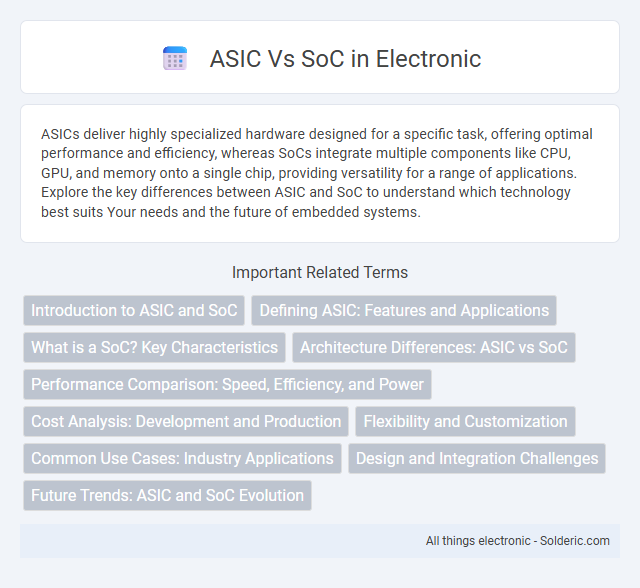ASICs deliver highly specialized hardware designed for a specific task, offering optimal performance and efficiency, whereas SoCs integrate multiple components like CPU, GPU, and memory onto a single chip, providing versatility for a range of applications. Explore the key differences between ASIC and SoC to understand which technology best suits Your needs and the future of embedded systems.
Comparison Table
| Feature | ASIC (Application-Specific Integrated Circuit) | SoC (System on Chip) |
|---|---|---|
| Definition | Custom-designed chip for a specific application | Integrated chip combining CPU, memory, peripherals on one die |
| Functionality | Single-purpose, optimized for one task | Multi-functional, supports multiple system components |
| Flexibility | Fixed functionality, limited adaptability | Highly flexible, programmable and supports diverse applications |
| Complexity | Lower complexity, focused design | High complexity due to integration of multiple components |
| Performance | Optimized for maximum speed and power efficiency in one task | Balanced performance across varied system components |
| Cost | High initial design cost, economical in large volumes | Moderate cost, cost-effective for complex systems |
| Use Cases | Cryptocurrency mining, signal processing, custom hardware acceleration | Smartphones, embedded systems, IoT devices, consumer electronics |
Introduction to ASIC and SoC
ASIC (Application-Specific Integrated Circuit) is a customized semiconductor designed for a particular application, offering optimized performance and power efficiency for specific tasks. SoC (System on Chip) integrates multiple components such as CPU, memory, and peripherals into a single chip, enabling compact and efficient system-level solutions. ASICs are tailored for specialized functions, while SoCs provide versatile, multifunctional platforms for a wide range of applications.
Defining ASIC: Features and Applications
ASIC (Application-Specific Integrated Circuit) is a custom-designed chip optimized for a specific task, offering high performance, low power consumption, and compact size compared to general-purpose processors. Common applications of ASICs include cryptocurrency mining, telecommunications, automotive systems, and consumer electronics, where specialized hardware acceleration is critical. These chips provide tailored solutions that enhance efficiency and speed in executing dedicated functions, distinguishing them from more flexible but less specialized SoCs (System on Chips).
What is a SoC? Key Characteristics
A System on Chip (SoC) integrates multiple components such as CPU, GPU, memory, and peripherals onto a single silicon chip, enabling compact and power-efficient designs. Key characteristics of an SoC include high integration density, reduced power consumption, and optimized communication between components, enhancing performance for mobile devices, IoT, and embedded systems. Your choice of SoC impacts device efficiency, speed, and overall functionality in complex applications.
Architecture Differences: ASIC vs SoC
ASICs feature a fixed architecture designed for a specific task, offering high performance and efficiency through dedicated circuits. SoCs integrate multiple components, such as CPU, GPU, memory, and peripherals, on a single chip, enabling versatile functionality and reduced system size. Understanding these architectural differences helps optimize Your design choices for power, cost, and flexibility.
Performance Comparison: Speed, Efficiency, and Power
ASICs deliver superior speed and efficiency by tailoring hardware specifically for a single application, resulting in lower latency and higher throughput compared to SoCs. SoCs integrate multiple components on one chip, offering moderate performance with enhanced versatility and easier development cycles. Your choice depends on whether you prioritize maximum performance and power savings (ASIC) or flexible functionality and quicker time-to-market (SoC).
Cost Analysis: Development and Production
ASIC development involves high initial design and mask costs, making it cost-effective only for large-volume production due to economies of scale. SoC integrates multiple functions on a single chip, reducing per-unit manufacturing costs and offering flexibility with lower upfront investment. Production of ASICs demands specialized fabrication processes, while SoCs benefit from standardized platforms, enabling faster time-to-market and scalable production expenses.
Flexibility and Customization
ASICs (Application-Specific Integrated Circuits) provide high customization tailored to specific tasks, offering optimized performance and efficiency for fixed functions. SoCs (System on Chips) integrate multiple components like CPU, GPU, and memory on a single chip, delivering greater flexibility to handle diverse applications and allow easier updates. While ASICs excel in specialized, high-volume use cases with low power consumption, SoCs support adaptability across multiple functionalities and rapid development cycles.
Common Use Cases: Industry Applications
ASICs dominate high-volume, specialized applications such as cryptocurrency mining, automotive safety systems, and consumer electronics due to their optimized performance and efficiency for specific tasks. SoCs integrate multiple components like CPUs, GPUs, and memory on a single chip, making them ideal for smartphones, tablets, and IoT devices where compactness and versatility are crucial. Your choice between ASIC and SoC will depend on whether you need tailored functionality with superior speed or multifunctional capabilities within limited space.
Design and Integration Challenges
ASIC design requires highly specialized knowledge to create custom circuits optimized for specific tasks, leading to complex integration challenges when incorporating multiple functions. SoC design integrates diverse components like CPUs, GPUs, memory, and peripherals on a single chip, demanding advanced verification and layout techniques to ensure seamless interoperability and power efficiency. Your choice between ASIC and SoC impacts development timelines and costs due to these differing design and integration complexities.
Future Trends: ASIC and SoC Evolution
ASICs are increasingly integrating AI accelerators and advanced security features to meet the demands of edge computing and autonomous systems. SoCs continue evolving with heterogeneous architectures, combining CPUs, GPUs, and custom accelerators on a single chip to optimize power efficiency and performance for mobile and IoT devices. The convergence of AI, 5G connectivity, and energy-efficient design drives the future trajectory of both ASIC and SoC development.
ASIC vs SoC Infographic

 solderic.com
solderic.com